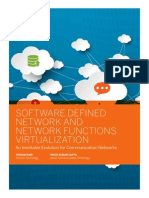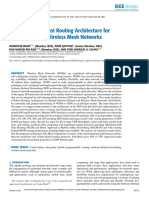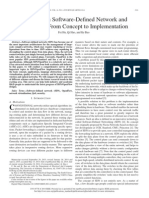0 ratings0% found this document useful (0 votes)
2K viewsSeminar Synopsis Format
Seminar Synopsis Format
Uploaded by
Mallesh KumarThis document is a seminar synopsis on Software Defined Networking (SDN) presented by a student. It discusses how SDN aims to simplify network management by separating the data and control planes. This allows for a centralized software program to control network behavior rather than relying on low-level device configurations. It introduces Procera, an SDN control framework that uses high-level languages to configure network policies that can automatically react to changes in network state across different domains like time, data usage, authentication status and traffic flow. The student has deployed Procera in campus and home networks to demonstrate how it can simplify common management tasks and support richer network policies.
Copyright:
© All Rights Reserved
Available Formats
Download as DOCX, PDF, TXT or read online from Scribd
Seminar Synopsis Format
Seminar Synopsis Format
Uploaded by
Mallesh Kumar0 ratings0% found this document useful (0 votes)
2K views3 pagesThis document is a seminar synopsis on Software Defined Networking (SDN) presented by a student. It discusses how SDN aims to simplify network management by separating the data and control planes. This allows for a centralized software program to control network behavior rather than relying on low-level device configurations. It introduces Procera, an SDN control framework that uses high-level languages to configure network policies that can automatically react to changes in network state across different domains like time, data usage, authentication status and traffic flow. The student has deployed Procera in campus and home networks to demonstrate how it can simplify common management tasks and support richer network policies.
Original Description:
VTU
Copyright
© © All Rights Reserved
Available Formats
DOCX, PDF, TXT or read online from Scribd
Share this document
Did you find this document useful?
Is this content inappropriate?
This document is a seminar synopsis on Software Defined Networking (SDN) presented by a student. It discusses how SDN aims to simplify network management by separating the data and control planes. This allows for a centralized software program to control network behavior rather than relying on low-level device configurations. It introduces Procera, an SDN control framework that uses high-level languages to configure network policies that can automatically react to changes in network state across different domains like time, data usage, authentication status and traffic flow. The student has deployed Procera in campus and home networks to demonstrate how it can simplify common management tasks and support richer network policies.
Copyright:
© All Rights Reserved
Available Formats
Download as DOCX, PDF, TXT or read online from Scribd
Download as docx, pdf, or txt
0 ratings0% found this document useful (0 votes)
2K views3 pagesSeminar Synopsis Format
Seminar Synopsis Format
Uploaded by
Mallesh KumarThis document is a seminar synopsis on Software Defined Networking (SDN) presented by a student. It discusses how SDN aims to simplify network management by separating the data and control planes. This allows for a centralized software program to control network behavior rather than relying on low-level device configurations. It introduces Procera, an SDN control framework that uses high-level languages to configure network policies that can automatically react to changes in network state across different domains like time, data usage, authentication status and traffic flow. The student has deployed Procera in campus and home networks to demonstrate how it can simplify common management tasks and support richer network policies.
Copyright:
© All Rights Reserved
Available Formats
Download as DOCX, PDF, TXT or read online from Scribd
Download as docx, pdf, or txt
You are on page 1of 3
VISVESVARAYA TECHNOLOGICAL
UNIVERSITY
Belgaum, Karnataka
Basaveshvara Engineering College
Vidaygiri, Bagalkot, Karnataka - 587102
Department of Computer Science & Engineering
Seminar Synopsis on
Software Defined Networking (SDN)
Presented By
Name: <>
USN: <>
For the academic year 2015-16
Under the Guidance of
Prof :
Department of Computer Science & Engineering
Basaveshvara Engineering College
Vidaygiri, Bagalkot, Karnataka 587102
Software Defined Networking (SDN)
Network management is challenging. To operate, maintain, and secure a
communication network, network operators must grapple with low-level
vendor-specific configuration to implement complex high-level network
policies. Despite many previous proposals to make networks easier to
manage, many solutions to network management problems amount to stopgap solutions because of the difficulty of changing the underlying
infrastructure. The rigidity of the underlying infrastructure presents few
possibilities for innovation or improvement, since network devices have
generally been closed, proprietary, and vertically integrated. A new
paradigm in networking, software defined networking (SDN), advocates
separating the data plane and the control plane, making network switches in
the data plane simple packet forwarding devices and leaving a logically
centralized software program to control the behavior of the entire network.
SDN introduces new possibilities for network management and configuration
methods. In this article, I identify problems with the current state-of-the-art
network configuration and management mechanisms and introduce
mechanisms to improve various aspects of network management. I focus on
three problems in network management: enabling frequent changes to
network conditions and state, providing support for network configuration in
a high level language, and providing better visibility and control over tasks
for performing network diagnosis and troubleshooting. The technologies I
describe enable network operators to implement a wide range of network
policies in a high-level policy language and easily determine sources of
performance problems. In addition to the systems themselves, I describe
various prototype deployments in campus and home networks that
demonstrate how SDN can improve common network management tasks.
Configuring computer networks is becoming increasingly vexing as network
operators must perform increasingly sophisticated network management
tasks. Two of the main reasons that networks remain difficult to manage are:
Continually changing network state
Low-level per-device network configuration The state-of-the-art methods for
network configuration do not allow network operators to configure network
policies that automatically react to low-level networking events, and they do
not allow operators to express network policies in terms of high-level intent.
Software defined networking introduces a vehicle for raising the level of
abstraction for network configuration, and designing languages and network
controllers that automatically react to frequent and continual changes to
network state. To simplify various aspects of network operations and
management, I have designed and implemented Procera, an event-driven
network control framework based on SDN. Network operators can use four
control domains time, data usage, authentication status, and traffic flow
to implement and enforce a reactive network policy with our high-level
configuration language based on functional reactive programming. I use the
OpenFlow protocol to communicate between the Procera controller and the
underlying network switches. I have deployed our system in both a campus
network and many home networks; our deployment experience and
evaluation show that Procera is feasible, introduce more possibilities for
expressing a richer set of network policies, and significantly reduce the
complexity of network management in a variety of network settings and for a
range of network policies.
You might also like
- Slow ProductivityDocument1 pageSlow ProductivityGuhan Selvam100% (1)
- Software Defined Networks and OpenFlowDocument105 pagesSoftware Defined Networks and OpenFlowaseaudiNo ratings yet
- Hochul Dossier, Volume III - ImmigrationDocument2 pagesHochul Dossier, Volume III - ImmigrationTeachoutWuCampaignNo ratings yet
- 18TE72 - Wireless Communication Experiential Learning ReportDocument10 pages18TE72 - Wireless Communication Experiential Learning ReportRitika BakshiNo ratings yet
- Traditional Network Architecture and SDNDocument9 pagesTraditional Network Architecture and SDNAqeel ZaffarNo ratings yet
- SDN PDFDocument2 pagesSDN PDFAyeshaNo ratings yet
- Neto-App: A Network Orchestration Application For Centralized Network Management in Small Business NetworksDocument12 pagesNeto-App: A Network Orchestration Application For Centralized Network Management in Small Business NetworksCS & ITNo ratings yet
- CCNA 7.0 DRAFT Scope and Sequence: Target AudienceDocument20 pagesCCNA 7.0 DRAFT Scope and Sequence: Target AudienceERNESTO TORRES RUIZNo ratings yet
- SDN Controller PcepDocument43 pagesSDN Controller PcepwallacemariadeandradNo ratings yet
- SDN Summary Report: AssignmentDocument16 pagesSDN Summary Report: AssignmentkokilaNo ratings yet
- Abdullah 2018Document45 pagesAbdullah 2018mohammed meladNo ratings yet
- Simplification of Internet Ossification Through Software Defined Network ApproachDocument5 pagesSimplification of Internet Ossification Through Software Defined Network ApproachAnonymous lPvvgiQjRNo ratings yet
- SDN in Wide-Area Networks A SurveyDocument6 pagesSDN in Wide-Area Networks A SurveyAbizwagNo ratings yet
- Paper 88-Analysis About Benefits of Software Defined Wide Area NetworkDocument11 pagesPaper 88-Analysis About Benefits of Software Defined Wide Area NetworkAkbar aliNo ratings yet
- Software Defined Networking Challenges and FutureDocument9 pagesSoftware Defined Networking Challenges and FuturePhu nguyen doanNo ratings yet
- ND - Assignment7 - Roshan Kumar ThapaDocument5 pagesND - Assignment7 - Roshan Kumar Thapasw.dvbimalNo ratings yet
- Sambhav Technical Seminar Presentation TemplateDocument16 pagesSambhav Technical Seminar Presentation Templaterishavkumar1402No ratings yet
- Software Defined Network and Network Functions VirtualizationDocument16 pagesSoftware Defined Network and Network Functions VirtualizationSaksbjørn Ihle100% (1)
- Soft-Mesh a Robust Routing Architecture for Hybrid SDN and Wireless Mesh NetworksDocument16 pagesSoft-Mesh a Robust Routing Architecture for Hybrid SDN and Wireless Mesh NetworksnurinNo ratings yet
- MN621 Advanced Network Design Group Assignment - Assignment 2Document7 pagesMN621 Advanced Network Design Group Assignment - Assignment 2Akshay Kumar TapariaNo ratings yet
- Software Defined NetworkingDocument23 pagesSoftware Defined NetworkingNiamNo ratings yet
- Traffic Engineering SDN SurveyDocument12 pagesTraffic Engineering SDN SurveyRafael FGNo ratings yet
- Network TransformationDocument6 pagesNetwork TransformationMumtaz AhmadNo ratings yet
- 06819788Document26 pages06819788Allan LeandroNo ratings yet
- NFV SDNDocument6 pagesNFV SDNPT. Telemedia Prima NusantaraNo ratings yet
- Simulation Analysis of Characteristics and Application of Software-Defined NetworksDocument6 pagesSimulation Analysis of Characteristics and Application of Software-Defined NetworksS M Shamim শামীমNo ratings yet
- Hakiri Et Al. - 2014 - Software-Defined Networking Challenges and Research Opportunities For Future InternetDocument19 pagesHakiri Et Al. - 2014 - Software-Defined Networking Challenges and Research Opportunities For Future InternetShaun NevilleNo ratings yet
- Unit 2-Chap 1 - Modern NetworkingDocument18 pagesUnit 2-Chap 1 - Modern NetworkingTim CookNo ratings yet
- In Software Defined Networking EnvironmentDocument23 pagesIn Software Defined Networking EnvironmentMohammed AkeelNo ratings yet
- High Performence SDWLANDocument21 pagesHigh Performence SDWLANadroidtivi178No ratings yet
- CiscoDocument20 pagesCiscoSri CharanNo ratings yet
- Enhancing Rural Connectivity With Software Defined NetworksDocument2 pagesEnhancing Rural Connectivity With Software Defined NetworksBoopathy PandiNo ratings yet
- Eng 1Document9 pagesEng 1redialamsyah650No ratings yet
- F-IoT Unit-4Document101 pagesF-IoT Unit-4Harshini Reddy RevuriNo ratings yet
- Syed Ali-Raza-CVDocument3 pagesSyed Ali-Raza-CVadnanNo ratings yet
- CG Lab Proj Front PageDocument18 pagesCG Lab Proj Front Page033 M. MehranNo ratings yet
- SDN Unit 1 NotesDocument9 pagesSDN Unit 1 Notesdinesh kumarNo ratings yet
- Unit V NDDocument24 pagesUnit V NDp rajeshwariNo ratings yet
- 4th UnitDocument8 pages4th UnitCh Shanthi PriyaNo ratings yet
- Report Format No4r345Document34 pagesReport Format No4r345likhithp1ga20is067No ratings yet
- 2016 SummerStudentReport IvanNikolic PDFDocument17 pages2016 SummerStudentReport IvanNikolic PDFደስታ ጌታውNo ratings yet
- SDN NotesDocument98 pagesSDN Notessubhasuji86No ratings yet
- Presentation VssDocument20 pagesPresentation VssTayyab NajeebNo ratings yet
- Pre Print Comnet2014Document7 pagesPre Print Comnet2014Boopathy PandiNo ratings yet
- 07140315Document9 pages07140315nyenyedNo ratings yet
- Loadbalancerpaperpublished PDFDocument8 pagesLoadbalancerpaperpublished PDFThang Tran ThanhNo ratings yet
- The Future of Software-Defined Networking (SDN)Document2 pagesThe Future of Software-Defined Networking (SDN)taosmonsta11No ratings yet
- SDN1Document39 pagesSDN1KieylNo ratings yet
- Evaluation Method For SDN Network Effectiveness in Next Generation Cellular NetworksDocument8 pagesEvaluation Method For SDN Network Effectiveness in Next Generation Cellular NetworksChaimaa GhazzaouiNo ratings yet
- FINAL ChapterDocument38 pagesFINAL ChapterMinaz MinnuNo ratings yet
- Rajesh RDocument2 pagesRajesh RSanjayVasu1993No ratings yet
- 1406.0124v1Document24 pages1406.0124v1j.nyambeyaNo ratings yet
- Hu 2014Document27 pagesHu 2014Noor FatimahNo ratings yet
- Software-Defined Wide Area Network (SD-WAN) : Architecture, Advances and OpportunitiesDocument9 pagesSoftware-Defined Wide Area Network (SD-WAN) : Architecture, Advances and Opportunitiesjirokun13042003No ratings yet
- Open-Source Network Optimization Software in The Open SDN/NFV Transport EcosystemDocument14 pagesOpen-Source Network Optimization Software in The Open SDN/NFV Transport EcosystemAldo Setyawan JayaNo ratings yet
- A Survey of Software-Defined Networking: Past, Present, and Future of Programmable NetworksDocument1 pageA Survey of Software-Defined Networking: Past, Present, and Future of Programmable Networksarjun kumarNo ratings yet
- Assignment 1Document5 pagesAssignment 1sw.dvbimalNo ratings yet
- A Survey On Software-Defined Network and OpenFlow - From Concept To ImplementationDocument26 pagesA Survey On Software-Defined Network and OpenFlow - From Concept To ImplementationHải ĐàmNo ratings yet
- Chapter Quizes - DocxagaDocument20 pagesChapter Quizes - DocxagawefjwqygfggfNo ratings yet
- Research Article: A Processor-Sharing Scheduling Strategy For NFV NodesDocument11 pagesResearch Article: A Processor-Sharing Scheduling Strategy For NFV NodesJoseph NguyenNo ratings yet
- Software Defined Networking (SDN) - a definitive guideFrom EverandSoftware Defined Networking (SDN) - a definitive guideRating: 2 out of 5 stars2/5 (2)
- Popular Science October 2015Document84 pagesPopular Science October 2015OnyxNo ratings yet
- Lab - Determination of Iodine Concentration by TitrationDocument2 pagesLab - Determination of Iodine Concentration by TitrationSappNo ratings yet
- Film Making: Learn Basics To Becoming A Film MakerDocument26 pagesFilm Making: Learn Basics To Becoming A Film Makertanzil mohmud shah100% (2)
- Project Slide - 2ndDocument18 pagesProject Slide - 2ndFenil JoseNo ratings yet
- HettCube en Low-Res (Volumen Util)Document12 pagesHettCube en Low-Res (Volumen Util)Diego RomeroNo ratings yet
- A Visit From The Goon Squad (Excerpt)Document15 pagesA Visit From The Goon Squad (Excerpt)VintageAnchor60% (5)
- Scoping Report FormatDocument12 pagesScoping Report FormatJona100% (1)
- Affidavit of Insurance ClaimsDocument2 pagesAffidavit of Insurance Claimsشزغتحزع ىطشفم لشجخبهNo ratings yet
- Kinetic Energy of Rigid Bodies PDFDocument7 pagesKinetic Energy of Rigid Bodies PDFGooftilaaAniJiraachuunkooYesusiinNo ratings yet
- Drying PDFDocument48 pagesDrying PDFuzzal ahmedNo ratings yet
- Introduction To The Flora and Fauna of OdishaDocument11 pagesIntroduction To The Flora and Fauna of Odishajitendramakwana350No ratings yet
- Bio 235 F 12 Final Exam AnswersDocument12 pagesBio 235 F 12 Final Exam AnswersSmartunblurrNo ratings yet
- Apply Within.: Wanted: Hard Worker Double The Exposure!Document2 pagesApply Within.: Wanted: Hard Worker Double The Exposure!Tara SmithNo ratings yet
- Hydrastep & Hydratect: Water/steam Monitoring SystemsDocument8 pagesHydrastep & Hydratect: Water/steam Monitoring SystemsSrinivasarao YenigallaNo ratings yet
- Module Title: Mechanical Materials (3D) : MECH8012Document4 pagesModule Title: Mechanical Materials (3D) : MECH8012Maurício SouzaNo ratings yet
- Pomegranate FarmingDocument13 pagesPomegranate FarmingNavneet JaiswalNo ratings yet
- IDC-401 Theoretical Biology: Lotka - VolterraDocument7 pagesIDC-401 Theoretical Biology: Lotka - VolterraDevender YadavNo ratings yet
- Internship in MissionEdDocument2 pagesInternship in MissionEdschtiksNo ratings yet
- Nagoya Stroll Course: Walk Through Nagoya's Constantly Developing City CenterDocument1 pageNagoya Stroll Course: Walk Through Nagoya's Constantly Developing City CenteralelendoNo ratings yet
- Radioactive Radon ReportDocument2 pagesRadioactive Radon Reportapi-397961257No ratings yet
- Retno Hanani, 2021Document10 pagesRetno Hanani, 2021esa nursalsabilaNo ratings yet
- Periodontics Question BankDocument15 pagesPeriodontics Question BankguruprasathNo ratings yet
- Sample Paper SST: Biology / ChemistryDocument7 pagesSample Paper SST: Biology / ChemistryOmar KhanNo ratings yet
- Damage in Concrete Due To Faulty WorkmanshipDocument2 pagesDamage in Concrete Due To Faulty WorkmanshipBhanu Chandu MakineniNo ratings yet
- A1 EEP-I Project Final ReportDocument16 pagesA1 EEP-I Project Final ReportSAURAV KUMAR GUPTANo ratings yet
- Stainless Steel Crown in Clinical Pedodontics - A ReviewDocument5 pagesStainless Steel Crown in Clinical Pedodontics - A ReviewmztahuNo ratings yet
- King I. Phillips Despite: Department of Microbiology, ST Thomas's Hospital Medical School, London SEI 7EHDocument12 pagesKing I. Phillips Despite: Department of Microbiology, ST Thomas's Hospital Medical School, London SEI 7EHLeandro LopezNo ratings yet
























































































